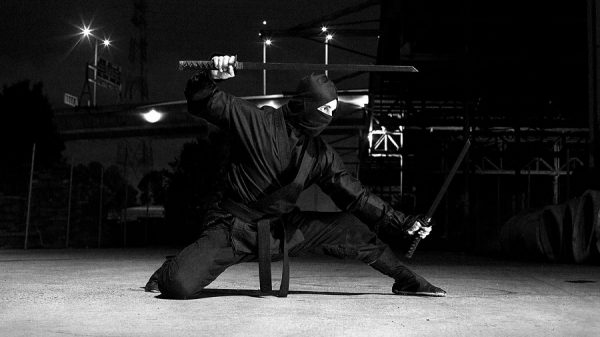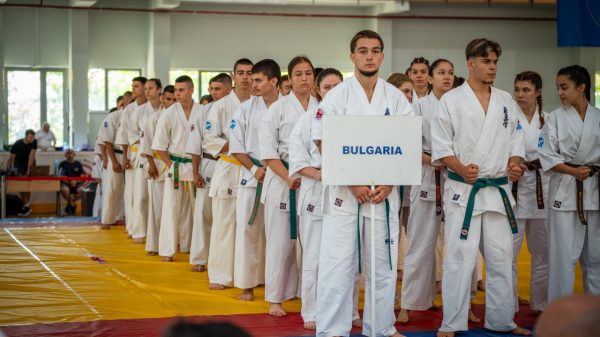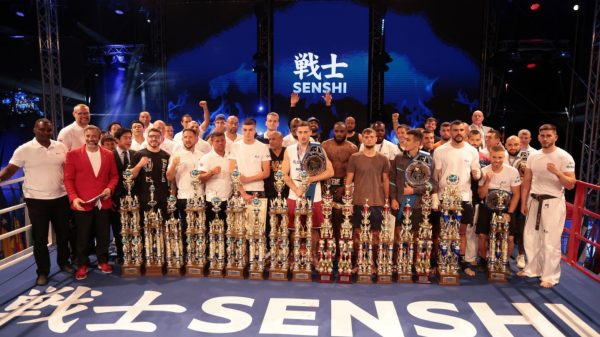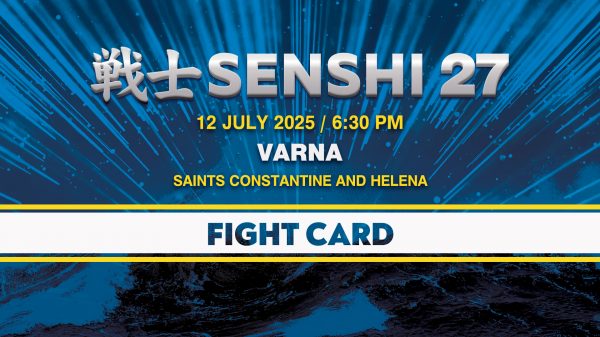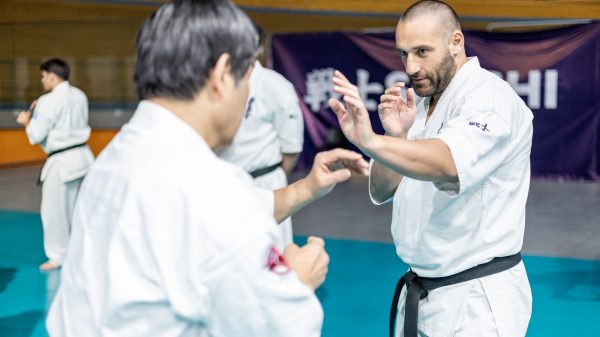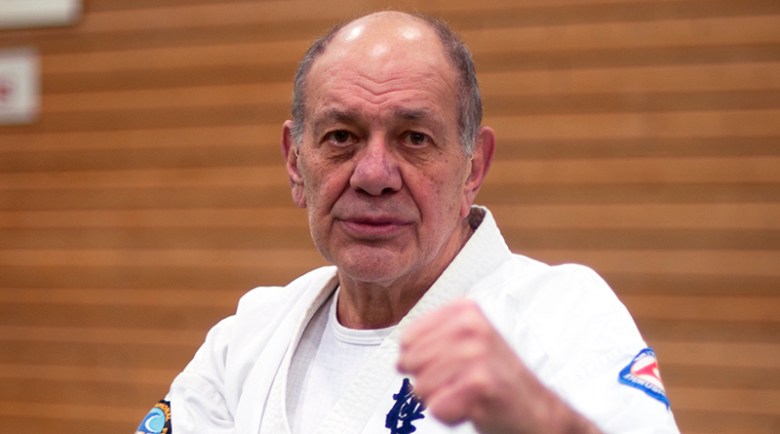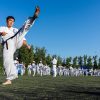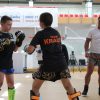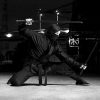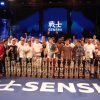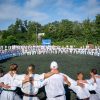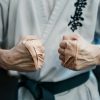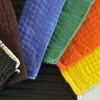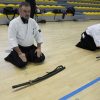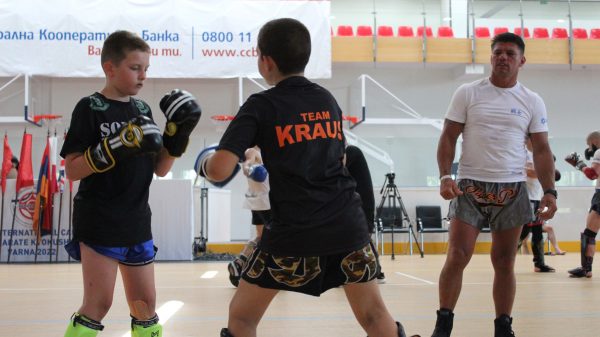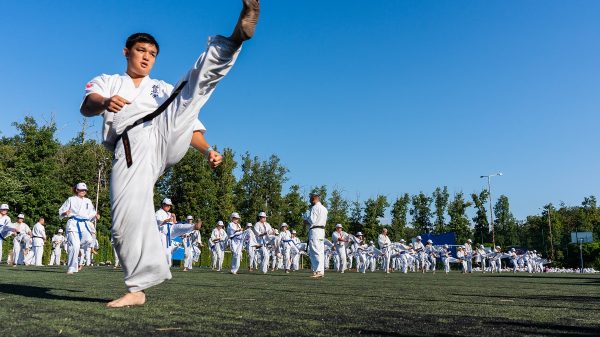No man typifies this principle more than Steve Arneil. He was the second man to complete the grueling One Hundred Man Kumite Challenge, after the great Masutatsu (Mas) Oyama.
Steve Arneil, the son of a steelworker, was born on 29 August 1934 in the mining city of Krugersdorp, South Africa.
Arneil’s martial arts journey started when he aged twelve he began learning Judo from Allen Robinson, the son of famous judoka, Jack Robinson. The Arneil family had earlier moved to Northern Rhodesia (now Zambia) where Arneil’s father worked as a smelter in a copper mine.
Although Arneil dabbled a little with boxing, an operation on his nose put an end to that. In 1950 he earned his 1st Dan in Judo. It was around this time that he came into contact with an old Chinese man he saw practicing Kempo and Tai Chi outside his hardware store. Arneil persuaded the man to teach him his style. He studied with him for the next two years.
It should be mentioned that Arneil was a keen rugby player, becoming one of the youngest players to represent Northern Rhodesia. He played in matches against Southern Rhodesia (now Zimbabwe) and an invitation team from England and Wales.
On a visit to Durban, South Africa Arneil first learned about Karate from some Judo friends. His first introduction to Karate was from an Okinawan man who taught him the style of Goju-ryu for about a month.
In 1958, at the suggestion of his now very old Kempo instructor, Arneil traveled to China via South Africa (to gather finances for the trip). He stayed at a YMCA hostel in Hong Kong for six months. Unhappy with the Kung Fu dojo he was training at, he made an unsuccessful attempt to enter mainland China. He eventually ended up in the Philippines, where he stayed for around six weeks, working on ships and learning knife fighting techniques.
Arneil’s old Kempo teacher had mentioned a karateka who was reputably known for his great strength and discipline. This man was Mas Oyama. In 1961 Arneil traveled to Yokohama, Japan in search of Oyama.
Once in Japan Arneil traveled to the Kodakan, the headquarters of Judo, located in Tokyo. It was there that he met the famed martial arts practitioner and historian, Donn Draeger. The American, a fluent Japanese speaker, had previously trained with Oyama and offered to introduce him to Arneil. They traveled to Oyama’s Ikebukuro dojo. Oyama’s style of Karate was Kyokushin, meaning the ultimate truth. At the time of the visit, Oyama was in the United States. Arneil was introduced to Kenji Kurosaki who was running the dojo in Oyama’s absence.
With the absence of Oyama from the dojo, Arneil was not allowed to train. However, he was allowed to observe training. For the next six months, he would travel to the Ikebukuro dojo to watch the classes. He would eventually leave without anyone at the dojo speaking to him or even acknowledging him.
Oyama eventually returned from his travels. Arneil was introduced to him by Draeger. Much to his surprise, Oyama asked if he had seen any other Karate styles while in in Japan. He would not be accepted into the dojo until he had experienced some of the Karate styles available.
Arneil visited the JKA to view their brand of Shotokan Karate. He then visited the dojo of legendary Goju-ryu Karate master, Gogen Yamaguchi, who offered to accept him as a student. Although Arneil like the Goju-ryu style his heart was set on learning Kyokushin Karate. After several weeks he returned to Oyama’s dojo where he was allowed to begin his Kyokushin training.
As expected, training at the Ikebukuro dojo was hard. The rules of the dojo were simple. Students were expected to do as they were told otherwise they were out. White belts would be drilled in the same basic techniques for hours before they were allowed a new technique. There was also a strict hierarchy in place at the dojo. White belts were expected to clean the dojo and toilets. They were also required to wash the uniforms of the black belts.
At this time Arneil was living a few miles away from the dojo in a single room in Aoyama. He eventually became a uchi deshi (live in student). He was own in a foreign country, struggling with the language and finding the cuisine difficult to eat. The training was also very grueling. It was a daily affair lasting five to six hours. It was not uncommon for the class to perform a thousand kicks in a training session. Every day the class would spend an hour fighting against the black belts.
Arneil stuck with the training. He had saved some money from his time working in South Africa. This meant he could dedicate himself to training full time. He rose through the ranks and was eventually given the chance to grade for his 1st Dan.
Unfortunately for Arneil he failed his grading. In his own words, he had been a little arrogant, thinking that passing his grading was a mere formality. He had even purchased a black belt. At the time of the failure, he was very disappointed, thinking he may have failed because he was a foreigner. He now believes that he failed because Oyama did not think he was mentally ready to hold the rank of the black belt even though physically he was capable. He believed failure would teach him humility.
Failure and subsequent hard training taught Arneil a lot about himself. In 1963, six months after his failed grading he re-took the grading exam and passed. Three weeks later he received his black belt from Oyama. His whole life was about Karate. In 1964 he received his 2nd Dan.
The funds Arneil had saved prior to arriving in Japan was beginning to run out. To support himself, he took a job as a translator for a machine company. He later worked as an English conversation teacher for various banks, schools, and institutes. It was during this time he met his wife Tsuyoko. It was around this time he ventured into acting. He has appeared in over sixty movies, including a role in the 1967 James Bond film “You Only Live Twice”.
Oyama approached Arneil Arneil in 1965 to attempt the One Hundred Man Kumite Challenge. The challenge, devised by Oyama, was designed to test if a karateka had the necessary endurance and character to fight one hundred men in succession, without a break. If the karateka was knocked down for more than five seconds then they failed the challenge. It was not about winning but about surviving. Kicks were allowed to the face and joints of an opponent. Oyama was the only man to have taken and completed the challenge. Other karateka had attempted and failed the challenge.
Arneil began the grueling training required for taking One Hundred Man Challenge. The training lasted over five months. He stopped working and dedicated to training hard every day. Oyama monitored and guide his training, but did not give a date when the challenge would occur.
On the morning of 22 May 1965 Arneil turned up for his normal training session and was told he would be doing the 100 Man challenge. His first fight was around fifteen seconds, with him knocking out an opponent. He would go on to knockout around thirty-four of his opponents. He did lose some fights, but importantly he survived. The challenge lasted around two hours forty-five minutes. At the end of the challenge, his body was covered in bruises.
Steve Arneil became the first non-Japanese and only the second man after Masutatsu Oyama to complete the One Hundred Man Kumite Challenge. Shortly after the challenge he graded for and was awarded his 3rd Dan.
In 1965 Arneil was preparing to return to Africa with his wife when Oyama asked if he would go to Britain to help in the establishment of Kyokushin Karate. He met up with an old friend, Bob Boulton a Kyokushin 2nd Dan, already living in the United Kingdom. Together in 1965, they founded the British Karate Kyokushinkai (BKK) organization in London. The following year Arneil was awarded his 4th Dan.
In 1966 Arneil was elected the manager and coach for the All-Styles Karate team, a position he held until 1975. It was during this time that the foundations were laid down for the future success of British Karate teams, long after he had left the position.
During his tenure as British Manager, Arneil coached some of the greatest British karateka. This included Billy Higgins, David ‘Ticky’ Donovan, Terry O’Neill and Bob Rhodes. His teams won a number of European Tournaments. The pinnacle of his career was the winning of the 1975 World Karate Championships, held at Long Beach, California. His team became the first non-Japanese team to be crowned Team Kumite World Champions. That same year the French Karate Federation awarded him the tile ‘World’s Best Coach’. He was flown out to Paris where he received the award from Karate Administrator Jacques Delcourt. It should be noted that he never received any such acclaim from the British.
By 1977 Arneil had graded to 7th Dan. He received his grade from Oyama at the Kyokushin headquarters in Tokyo, Japan.
In 1991 beset by political and financial pressures within Oyama’s International Karate Organisation (IKO), Arneil and the BKK resigned from the organization after a twenty-five-year association. That same year he founded his own Karate Association, the International Federation of Karate (IKF).
On 26 April 1994 Arneil’s teacher and mentor, Masutatsu Oyama, died aged seventy from lung cancer. Oyama’s IKO had become one of the world’s foremost Karate associations. His widow, Chiyako, approached Arneil, asking if he would lead the association. However, not wishing to become embroiled in the politics of worldwide organization he politely declined the offer.
Over the years Arneil has been primarily concerned with growing and promoting Kyokushin Karate around the world. This has been through the teaching of courses and seminars and also hosting tournaments.
For his services to the British Karate community, he was awarded his 8th Dan in 1992. In 2001 he was awarded his 9th Dan in recognition of his work to promote Kyokushin Karate around the world. On 23 July 2011, he was awarded his 10th Dan.
The spirit of Bushido runs deep in Steve Arneil’s veins. From being a stranger in a foreign land he met all the challenges that faced him, The Bushido spirit helped him conquer one of the hardest feats in Karate, thus becoming a true pioneer in Karate.
Article from findingkarate.com / Author: Patrick Donkor



